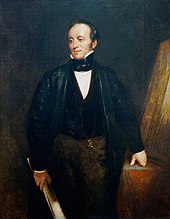Charles Barry
Sir Charles Barry RA (born May 23, 1795 in London ; † May 12, 1860 ibid) was an English architect and builder.
Live and act
After attending a private school and the death of his father Walter Edward Barry, Charles Barry invested his legacy in extensive travel. From 1817 to 1820, these took him to the Mediterranean and the Ottoman Empire . The Renaissance buildings in Italy impressed him so much that he decided to become an architect.
In the following years he built a variety of churches , buildings with representative functions and palaces , for example in Newbury , Manchester , Brighton and Salford .
Charles Barry's breakthrough as an architect came when he and Augustus Welby Northmore Pugin won an architecture competition in 1836 to build the Palace of Westminster in London, which was almost completely destroyed by a fire in October 1834. This building was rebuilt by him between 1840 and 1870 in the neo-Gothic style.
Sir Charles Barry was also responsible for the layout of Trafalgar Square (according to plans by John Nash ). He was also involved in the completion of Lancaster House in London.
In 1842 he was elected as a member of the Royal Academy of Arts and in 1849 as a member (" Fellow ") in the Royal Society . In 1852 he was knighted .
His son John Wolfe-Barry was a renowned civil engineer who built, among other things, Tower Bridge and played a leading role in the development of industry standards.
Buildings (selection)
- Royal Manchester Institution for the Promotion of Literature, Science And Art in Manchester (1824/25)
- Buile Hill House in Salford (1825 to 1827)
- Church of All Saints in Manchester (1827)
- Highclere Castle in Hampshire , about 6 km south of Newbury , southwest of London (1839/1842)
- Travelers Club in London (1832)
- Royal College of Surgeons of England in London (1834 to 1836)
- Palace of Westminster (1840 to 1852)
- Reform Club in London (1841)
- Trentham Gardens in Staffordshire (1842)
- Extension and remodeling of Dunrobin Castle at Gospie (1845-1851)
- Treasury building in London (1846 to 1847)
- Bridgewater House in London (1846)
- Cliveden House in Buckinghamshire (1849)
- Dunrobin Castle Gardens (1850)
- Shrubland Hall Gardens in Suffolk (1850)
- Big Ben , cooperation, he commissioned Augustus Welby Northmore Pugin to build the tower
literature
- Barry, Sir Charles . In: Encyclopædia Britannica . 11th edition. tape 3 : Austria - Bisectrix . London 1910, p. 443–444 (English, full text [ Wikisource ]).
Web links
- Entry to Barry; Sir; Charles (1795–1860) in the Archives of the Royal Society , London
- Database entry of the Royal Academy of Arts
| personal data | |
|---|---|
| SURNAME | Barry, Charles |
| BRIEF DESCRIPTION | English architect and builder |
| DATE OF BIRTH | May 23, 1795 |
| PLACE OF BIRTH | London |
| DATE OF DEATH | May 12, 1860 |
| Place of death | London |

